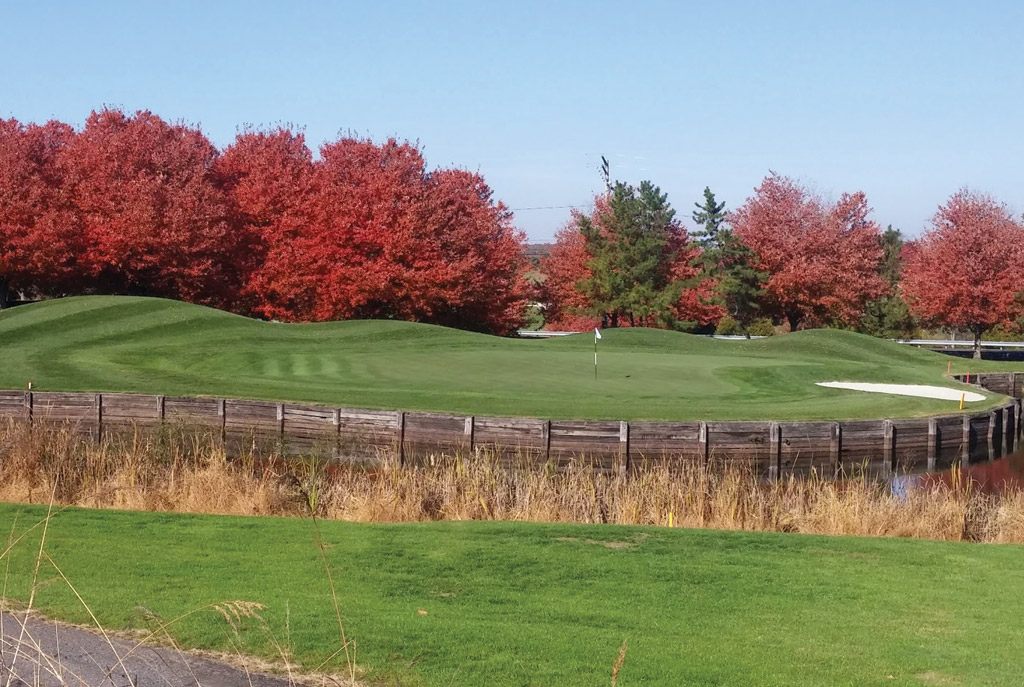[…]and Specifications for Soil Erosion and Sediment Control handbook provides detailed information on this topic and regulations. Erosion- and sediment-control regulations require developers, designers, and plan review agencies to consider runoff control from the start of any land development design process. Specific sediment-control requirements include the mapping of slopes steeper than 15%, of highly erodible soils, and of vegetative buffer strips; submitting a narrative describing how erosion and sediment control will be integrated into the stormwater management strategy; and providing a detailed sequence of construction that describes how the grading unit restriction will be met. Adhering to the planning principles […]
[…]with proper seedbed fertility. More information can be found in Nutrient Management Guidelines for Commercial Turfgrass Seeding. 2005. University of Maryland and the Nutrient Management section of this website. Best Management Practices The area to be established should be properly prepared. Ensure erosion and sediment control devices are in place and properly maintained. Conduct a soil test before seeding to determine nutrient needs. Sprigs should be “knifed-in” and rolled to hasten root establishment. Sod should be topdressed to fill in the gaps between sod pieces and seams. This hastens establishment and provides a smoother surface. Use appropriate seeding methods for […]
[…](pH), P, potassium (K), calcium (Ca), and magnesium (Mg). Additional tests can provide information on soil organic matter, soil micronutrients, and soluble salt levels, among other characteristics. Keeping soil test results from prior years will allow monitoring changes in soil nutrient levels over time and provide evidence of the impact of nutrient management plans. In Maryland, maintenance P applications must be based on soil test recommendations obtained at least every three years. The University of Maryland Extension maintains a list of soil test laboratories and guidance on conducting soil tests (see Selecting and Using a Soil Test Laboratory. 2013. University of […]
[…]Proper nutrition and irrigation often helps mask symptoms of ABW damage. For more information on ABW biology and control in Maryland, see Biology and Management of the Annual Bluegrass Weevil. 2005. University of Maryland. Best Management Practices Reduce the amount of annual bluegrass in infested areas. Remove overwintering habitat (i.e., pine litter and leaves). Monitor in the spring as adults migrate from overwintering and time insecticide applications for adults at peak migration time. Next: […]
[…]turf because it has better recuperative potential than stressed, unhealthy turf. For more information on the following turf diseases prevalent in Maryland and control methods, see: Maryland Turfgrass Disease Control Recommendations. University of Maryland. Red Thread and Pink Patch Diseases of Turfgrasses. 2007. University of Maryland. Identification and Management of Brown Patch. 2011. University of Maryland. Dollar Spot Disease of Turfgrasses. 2003. University of Maryland. Summer Patch Disease of Lawn Grasses. 2003. University of Maryland. Best Management Practices Ensure that proper cultural practices and traffic control that reduce turfgrass stress are used. Correct conditions that produce stressful environments for the […]
[…]their drainage capability concept is guided by an average rainfall event of a given frequency. For example, a golf course drainage system is typically designed to detain a two- or five-year rain event, reasonably draining the precipitation in a matter of hours, as excess water not absorbed by the soil flows through the drainage system, is temporarily held, and finally leaves the property. In some instances, golf courses are mandated to handle a 20-, 50-, or 100-year rain event, which means the golf course must detain more water for perhaps a longer period of time. This ability to detain large […]
[…](USGA). Golf Course Superintendents Association of America GCSAA is the professional association for the men and women who manage and maintain the game’s most valuable resource: the golf course. Today, GCSAA and its members are recognized by the golf industry as one of the key contributors in elevating the game and business to its current state. Since 1926, GCSAA has been the top professional association for the men and women who manage golf courses in the United States and worldwide. From its headquarters in Lawrence, Kansas, the association provides education, information, and representation to more than 17,000 members in more […]
[…]The regulations include a permitting or authorization process implemented in close coordination with the federal government, specifically the Army Corps of Engineers. While there are some exemptions from permitting requirements for certain activities, permits or letters of authorization from the state are generally required if a property owner plans to undertake an activity that results in the draining of a wetland or the addition of fill materials to a state-regulated wetland or waterway. All state regulations that pertain to wetlands are provided by MDE in a wetlands regulation database. Floodplains Any activity associated with construction or renovation, including grading and […]
[…]of properly managed turfgrass. The National Turfgrass Evaluation Program (NTEP) provides information on the testing and adaptation of the turfgrass cultivars, searchable by state and NTEP test location. Maryland test results and recommendations can be found on the NTEP website. Recommendations for Maryland are also published and updated annually in Recommended Turfgrass Cultivars for Certified Sod Production and Seed Mixtures in Maryland. 2016. University of Maryland. When selecting cultivars for a specific site, considerations include the desired use, site and microclimate conditions, disease resistance, and spring transition traits. The Maryland Department of Agriculture administers the Maryland Certified Sod program. Certified sod […]

